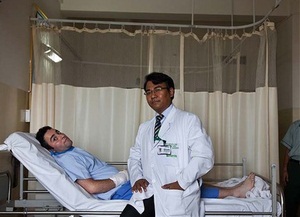Bruce Pearson was leading a gardening tour in Thailand early last year when his chronic back pain got so bad that his friends convinced him to check into a local hospital.
After half a day in a private room with the doctor himself massaging his sore back, Mr. Pearson, like any good American, shuddered to think what his bill would be.
The bottom line? $12.
In December, the Boynton Beach, Fla., nursery owner was told by his American doctors that he would need spinal fusion surgery. The price he was quoted was close to $70,000, and under his American States individual health insurance policy, he would be responsible for $14,000 of the tab.
So Thailand beckoned again.
This time, Mr. Pearson, who just turned 60, checked in to the sleekly modern Bumrungrad International Hospital in Bangkok, where he received a less radical form of spinal surgery that has made him feel like a new man.
The second bottom line? For the surgery, a four-day hospital stay, an extra week in a recuperation center and round-trip plane tickets for himself and a partner, the total bill came to just under $7,000.
Bruce Pearson had thus become a willing volunteer in of one of the fastest-growing trends in modern health care — “medical tourism,” or going overseas for cheaper medical treatment.
While no one officially tracks the phenomenon, the statistics at Bumrungrad International give a sense of how fast it is growing.
Last year, Bumrungrad treated 58,000 American patients, 70 percent of whom traveled there especially for such procedures as hip and knee replacement, angioplasty and prostate removal, said spokesman Ruben Toral. That was 25 percent more U.S. patients than it treated in 2004, he said, and so far this year, American patients are running 20 percent above last year’s figures.
Medical tourism has existed for years, but until recently, it mainly consisted of Americans traveling abroad for cosmetic surgery, or wealthy foreigners coming to the U.S. for organ transplants and other advanced medical procedures.
Today, however, travel to India, Thailand, Malaysia and Latin America for medical care is being driven by Americans who don’t have health insurance or have only minimal coverage.
A report by the U.S. Census Bureau last month said that the number of Americans with no health insurance climbed nearly 3 percent in 2005 to 46.6 million.
While many of those people are the working poor, “what doesn’t often come out is that 15 million of those people have family incomes of at least $85,000 a year,” said Thomas Keesling, founder of IndUShealth, a North Carolina agency that is routing American patients to India.
Many of those folks are self-employed business owners such as Bruce Pearson, or professionals who have been denied insurance coverage because of pre-existing conditions, or employees who are being asked to bear an increasing share of their companies’ health insurance premiums.
At some companies, the typical premium for a family of four is $11,000 a year, and employees are being asked to pick up 25 percent to 30 percent of that amount, so that “you’re out several thousand dollars before you even draw on the health care delivery system for anything,” said Paul Mango, head of the North American health care practice at consulting firm McKinsey & Co.
Mr. Pearson’s policy requires him to pay the first $5,000 of his medical costs and 20 percent of the remainder up to $50,000, after which catastrophic coverage kicks in. At Bumrungrad, he had to pay his fee in cash ahead of time, but given the outcome and the savings, he was more than happy to do that.
He is far from alone. Attracted by the growing number of foreign hospitals with highly qualified surgeons and much lower costs, many underinsured Americans are contacting medical tourism travel agencies to arrange such trips.
One of the newer agencies is Medical Tourism of Costa Rica, set up about a year ago by former Pittsburgher Richard Feldman.
Mr. Feldman, who lived in Point Breeze for 14 years, knows he can’t quite match the medical treatment costs in Asia, but he can offer a plane trip of just three to four hours from the United States, compared with 20 hours to India or Thailand.
And he notes there are still significant savings for patients who go to Costa Rican hospitals for dentistry or weight loss and cosmetic surgeries.
Gastric bypass surgery there, for instance, costs $16,000, he said, so that even with another $2,500 added in to cover plane fare, food, transportation and hotel, it is still a major savings over the $35,000 an American hospital might charge.
Medical fees in Costa Rica are lower not only because of the cheaper cost of living, Mr. Feldman said, but because the country cares for its poorer patients in public hospitals, so the private hospitals that cater to tourists don’t have to pass along the cost of that care.
Malpractice expenses also are much lower. People can file claims in Costa Rican courts, he said, but they generally are encouraged to settle rather than go to trial.
The story in Bangkok is similar.
At Bumrungrad Hospital, Mr. Toral said, the lower cost of living is a major factor in the savings, but so are differences in how the medical system operates.
Doctors in Thailand pay about $5,000 a year for malpractice insurance, compared with more than $100,000 for some specialties in the United States.
Thai courts will adjudicate malpractice claims, but the largest award ever issued was about $100,000, Mr. Toral said, and the law there doesn’t permit damages for pain and suffering.
Another major savings, he said, is that Bumrungrad doesn’t have to spend much on processing insurance claims, since 75 percent of its patients pay cash.
“You can come to our hospital and pay for major surgery on your credit card,” he said. “You could never do that in the states.”
Bumrungrad also likes to promote its quality.
The hospital is accredited by the international branch of the same organization that accredits U.S. hospitals, Mr. Toral said, and 145 of its doctors are board-certified or were trained in the United States, United Kingdom or Germany.
While it’s true that most foreign nations seeking medical tourists don’t offer the kind of malpractice settlement possibilities that the United States does, that doesn’t mean they have less incentive to provide high-quality care, industry executives say.
The hospitals “understand that if something negative was said about them in the U.S., it would have a big impact on their ability to serve the North American market,” said Patrick Marsek, managing director of MedRetreat, a medical tourism agency based in Maryland.
Rick Wade, senior vice president for communication at the American Hospital Association, said he has no doubt that some international hospitals are just as high-quality as their U.S. counterparts.
But he believes most Americans will not end up going overseas for medical care. “It will be limited by the desire of people to be someplace near to where their family and their social support system is,” he said.
Still, Mr. Wade said the economic forces that are driving some people to go abroad for medical care are very real and need to be fixed.
While the hospital association doesn’t support a single-payer health insurance system such as Canada’s, it does believe there should be a system in America that “would make some kind of basic health insurance affordable and available to everybody.”
Until that happens, thousands of Americans will seek care overseas.
Soon, some employers and commercial insurance companies may start to consider overseas care as a lower-cost alternative to U.S. hospitals — in effect, “outsourcing” expensive medical procedures.
IndUShealth, the North Carolina agency, is talking with 12 employers and two insurance companies about possible coverage of overseas health care costs, Mr. Keesling said. One of the companies, employee-owned Blue Ridge Paper Co., of Canton, N.C., was planning to send its first worker to get surgery in India this month, he said.
In West Virginia, Republican legislator Ray Canterbury has proposed allowing state employees to go overseas for health care if they want, as long as the cost, including travel and accommodations, is less than the expense in the United States.
The bill is in a special study committee that will take it up next year. Mr. Canterbury hopes that the state legislature will at least approve a pilot program testing overseas care.
Medical tourism executives and consultants agreed that international travel for health care will probably accelerate in coming years.
“I tell people these are actually the good old days in health care,” Mr. Keesling said. “With all the baby boomers aging, it’s going to put a tremendous burden on the health care system that we can’t begin to imagine.”
Arnold Milstein, chief physician for Mercer Health and Benefits in San Francisco, agreed, but he cautioned that medical tourism by itself is unlikely to lead to major changes in the American health care system.
He said actuaries at his consulting firm estimate that the maximum potential for patients going overseas still amounts to only 1 or 2 percent of all U.S. surgeries — not enough to force an upheaval in the way health care is financed in this country.
Nevertheless, Bruce Pearson has no trouble recommending Thailand to anyone facing major surgery.
“I don’t know how U.S. medicine can even compete. They don’t have the high wages there, the Thais are caring and incredibly enthusiastic, and I can’t say enough good things about the four doctors I had.
“I mean, when I was in the hospital there, my biggest worry was whether I should have the lobster salad or the thinly sliced tuna in red wine sauce.”
source: http://www.post-gazette.com / Pittsburg Post-Gazette / by Mark Roth / first published March 17th, 2012



